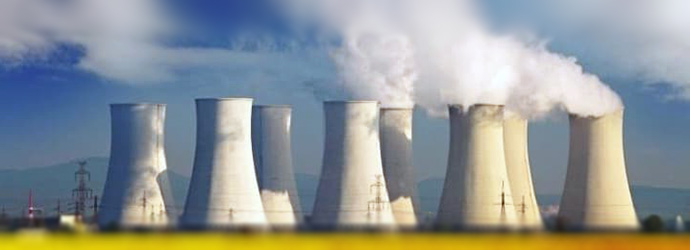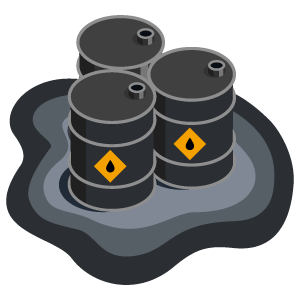What is Nuclear Energy & how is it produced?

Nuclear energy is often touted as a reliable source of low carbon energy for the UK. How green it is is a source of heated debate. While there is no denying the unmatched power output of nuclear energy, the industry also has a dark side. Is nuclear better than solar, wind and tidal energy put together? Are nuclear power plants safe? Let’s find out.
How is nuclear energy produced?

Nuclear energy is produced through a process called nuclear fission. Put simply, this is a process of splitting atoms up to form smaller atoms, which releases energy in the form of heat. In a nuclear power plant, this energy is used to heat water and turn it to steam, which in turn spins turbines in order to create electricity.
Nuclear fission takes place inside the reactor of the nuclear power plant, the core of which contains uranium fuel. This uranium comes in the shape of ceramic pellets, each of which can produce the same amount of energy as around 700 litres of oil.
In many instances, the steam produced by nuclear plants is turned back into water in the power plant's cooling tower and is reused. Not all nuclear plants have cooling towers, however, and some use water from rivers, lakes or the ocean.
What are 3 sources of nuclear energy?
Nuclear energy production has been in development since the 40s and there has been several approaches to harnessing the power of the atom for energy generation. While the basic principle that heat is produced to drive steam turbines holds true for all reactors, the way in which the reaction is controlled does vary. In this section, we'll take you through the three main reactor variants in operation today.
1. Gas-cooled reactors (AGR)
This is the dominant nuclear reactor type in the UK. It uses inert gases like helium and carbon dioxide to cool the reactor core. A heat exchanger runs in and out of the reactor, it turns water into steam which is sent to a turbine. Key parts of the reactor include graphite moderators which slow down neutron particles sufficiently to generate heat, making the reactor more energy-efficient, and control rods which absorb neutrons in order to slow down or entirely shut down the chain reaction as a safety precaution.
2. Pressurised water reactors (PWR)
This reactor type is by far the most popular worldwide. Unlike British AGR designs, this reactor uses pressurised water to cool the reactor and therefore conduct heat to a steam generation vessel that is connected to the turbine. One notable variation of this design is that the steam generator vessel doesn’t pass through the reactor core itself. Instead, the pressurized primary water loop is circulated through the steam generator vessel, outside of the core.
The other major difference is that the water in the primary loop acts as the reaction moderator. This is often touted as a key safety feature because as water temperature increases molecules move further apart which reduces the chance of neutron collisions. This in turn can reduce dangerous heat build up within the reactor itself.
3. High power channel-type reactors (RBMK)
This reactor design was developed in the Soviet Union with the aim of producing electricity cheaply through a simple design that could operate safely as long as established parameters were followed without deviation. The flaw of this design was its deficient redundancy and safety systems, though this was later somewhat mitigated.
To reduce cost and facilitate online refuelling, it was built without complete containment structures beyond a simple biological shield, unlike the other two designs we’ve covered. From a broad standpoint, RBMK reactors are a mashup of AGR and PWR designs, using graphite rods and water simultaneously to moderate and cool the reactor. The lack of robust containment structures and idiosyncratic design principles unfortunately played a starring role in the Chernobyl disaster.
Nuclear power stations in the UK
The UK began to generate electricity from nuclear power in 1956. The main purpose of Calder Hall, Britain’s first power station, was the production of fissile material for nuclear weapons.
What is fissile material?Fissile material is radioactive matter capable of maintaining a nuclear chain reaction, which can be used as fuel or for military purposes. Fissile material, commonly extracted from uranium, is produced through the process of neutron capture.
The construction of nuclear power plants for civilian electricity generation began in earnest in the 60s and didn’t really let up until the tail end of the 80s. Nuclear sites were publicly owned until 1984, when they were folded into the then privatised British Nuclear Fuels company.
There is also the Sellafield plant which reprocessed both domestic and foreign spent nuclear fuel. The facility, which was also known as THORP (Thermal Oxide Reprocessing Plant), had a checkered operational history from 1997 to 2018, when it was finally closed down.
How many nuclear plants are there in the UK?
The UK has seven nuclear power stations that are currently operational, with each site hosting anywhere between one to four nuclear reactors. Only two of the active nuclear sites (Torness and Hunterston) are located in Scotland with the remainder being in England.
Between 2003 and 2015. Eleven nuclear sites were shut down. Some of these reactors had been in operation for over 40 years and included two Welsh sites (Wylfa and Trawsfynydd).
These numbers do not take into account research or military nuclear reactors which are smaller in scale but still require the same amount of care when it comes both to operation and nuclear waste disposal.
Nuclear power stations UK map
UK nuclear power stations take advantage of the expansive coastlines of the British Isles as a source of water required for their operation. For this reason, all commercial UK nuclear reactors are located by the sea.
Why is nuclear energy bad?

Nuclear power is not a renewable or sustainable form of energy. The most glaring reason is that a nuclear power station can produce up to 20 tonnes of radioactive waste in a single year. This figure comes from the Nuclear Energy Institute, a U.S. based pro-nuclear think tank.
Long-term storage for nuclear waste is a serious environmental issue that has no easy solution in sight. At the moment, deep geological repositories are being touted as the way forwards but concerns remain in terms of seismological stability over hundreds of years.
Even small details such as ensuring that signage effectively conveys the hazardous nature of the site to future generations and cultures has to be taken seriously. Underground nuclear waste storage facilities currently being planned will have to operate not for decades, but several centuries. The challenge radioactive materials pose is unprecedented.
While nuclear plants can be classed as a low-carbon energy generator, as long as they operate safely, that notion goes out of the window, not just during their construction phase but also as soon as decommissioning begins.
When you look at nuclear incident and disaster response from a safety standpoint, a scarily familiar pattern of causes emerges:
- Experts and veterans are ignored, sidelined or blacklisted.
- Corners are cut when it comes to procedures and equipment.
- Evacuation plans and other safety procedures are either ignored or non-existent.
- Confidence in the inherent safety of the plant design is always misplaced.
- Crisis management almost always comes down to a few good people putting everything on the line to deal with the incident.
- Blind luck is often required.
The issues that make nuclear power dangerous are not exclusive to one system of government or one nation - they originate in core human failings that are impossible to design against.
For example, during construction of the Windscale plant, a scientist called John Cockcroft insisted, despite widespread ridicule, that the facility be fitted with air scrubbers. Before the accident, government officials nicknamed them Cockcroft’s follies. These devices prevented 95% of airborne radioactive pollutants from escaping the facility during the Windscale nuclear pile accident. Had they not been installed, much more radiation would have escaped.
A British government official quipped that "the word folly did not seem appropriate after the accident," but very little changed in nuclear policy following the incident.
Valery Legasov, the soviet scientist largely responsible for preventing a much worse radioactive release during the Chernobyl disaster, was later ostracised and ridiculed by his country's scientific community. He committed suicide in 1988.
Today we are living in such a world that we are surrounded by many technologically complex, potentially dangerous systems both nuclear and non-nuclear. - Valery Legasov during an interview with NBC News in 1986
A nuclear accident can displace thousands of people and contaminate hundreds of square miles for decades. Even when they are operated safely, nuclear power stations still have to be decommissioned, which brings its own risks, exorbitant cost and generational toxic waste management.
On the other hand, with renewable energy, the worst case scenario would be wind turbine catching fire or a hydroelectric dam causing a deadly flash flood. While the former would be costly and the latter a rare tragic occurrence, the long term impact on human health, the environment and the economy for either incident would range between minimal to nil. This is something that the nuclear industry will never be able to honestly claim.
There is no denying that nuclear power output is as impressive as the science and engineering that makes it possible. However, it is time for the British government to recognise that nuclear energy is the increasingly inadequate and cowardly choice.
It belongs to a time when energy policy was based around utility-scale power plants pumping out electricity to be sent out through a national grid that loses up to 12% of the generated output before it even arrives to residential customers. Renewable energy does not thrive in such an outdated and inefficient system.
What’s the latest with Hinkley Point C?The Guardian has extensively reported on cost overruns, worker suicides, and regional environmental impact connected to the UK’s latest nuclear project. As of August 2019, the power station is at least two years behind schedule and its estimated cost is set to outstrip original estimates by 200%. The British public will end up footing the bill, with higher wholesale energy prices for years to come.
The future is all about a decentralised energy infrastructure capable of leveraging local storage as well as peer to peer energy trading where households with solar panels or electric cars can monetise their power generation and storage capacities, completely short circuiting energy companies. Nuclear energy seems to us to have no place in Britain’s renewable future.
Environmental impact of nuclear waste
Nuclear waste material falls into one of three categories based on how much radiation it emits into its surroundings and for how long.
Low-level nuclear waste can come from hospital radiology departments, universities and research centres as well as the nuclear industry. Waste in this category should not exhibit higher levels of ionizing radiation than similar materials found outside of nuclear facilities. However, it is treated as hazardous waste as a precautionary measure, in order to account for even a remote risk of radioactive contamination.
Intermediate-level radioactive waste demonstrates above-average radioactive emissions requiring effective shielding to be put in place. Chemicals, insulation and cladding in nuclear facilities, as well as materials collected during the decommissioning process, are often put in this category. Disposal usually takes the form of burial in shallow trenches, often onsite, to avoid the associated risks and costs of transportation and treatment in a remote location. The only exception to shallow repository disposal is reprocessed nuclear fuel which falls under the next category.
High-level nuclear waste usually originates in nuclear reactors. Once a fuel rod reaches the end of its cycle, it needs to be extracted from the reactor core. Nuclear waste in this category contains a wide variety of radioactive and unstable compounds that emit radiation for anywhere between a few hours to tens of thousands of years. This type of nuclear waste also requires active cooling because aside from radiation it also generates high levels of heat and poses a fire hazard which exacerbates its toxicity.
The cost of decommissioning nuclear sites
Nuclear reactor facilities contain a variety of radioactive materials running the whole gamut of half-lives, isotopes and particles. What this means is that winding down a nuclear power station is expensive, complicated and takes decades if not hundreds of years to completely clear a site from hazardous contaminated materials.
Nuclear issues and accidents in the UK
The UK has operated nuclear reactors for over 60 years, which means there is a surprising number of incidents that have occurred, both big and small.
Chapelcross is a now-decommissioned nuclear power station based on early British nuclear reactor designs which suffered from several safety breaches over the years.
- In 1967, nuclear fuel got stuck in a reactor channel leading to overheating, also known as fuel melt, and the failure of the Magnox cladding (Magnesium Aluminium alloy) that was supposed to contain any excess radiation. Such a failure was not anticipated by the Maximum Credible Incident philosophy the reactor was based on.
- There was a fatal accident on-site in 1978. No details were made public other than an acknowledgement of a small £200 fine paid by British Nuclear Fuels in relation to the death of a plant worker.
- In 2001, plant workers were exposed to a small dose of radiation when nuclear fuel was lifted out of its shielding accidentally. This occurred during a fraught refuelling procedure designed to occur while the reactor was still running.
Oldbury, Hunterston A and Hinkley Point A are a trio of decommissioned nuclear power plants sharing eerily similar operational issues.
- All three reactors suffered from steel component corrosion which impacted their operation and in some cases led to the shutdown of the power plants. However, even currently operational plants, such as Hartlepool, have been found to have corroded pipes, storage vessels and earthquake safety structures.
- Hinkley Point A suffered from turbine failure early on in its operational life. Thankfully, steam turbines are not part of the nuclear reactor itself otherwise the issue would have been more significant. Dungeness B, a fully operational plant, suffered a similar fate with a boiler annexe fire in 2009 which contributed to long term shutdowns in 2012.
Sizewell A was shut down in 2006 but its name will live on in infamy through its decommissioning process, which is estimated to cost £1.2 billion.
- In 2007, a decommissioning contractor who was washing his clothes in a launderette located on the premises noticed there was water leaking into the room. Further inspection showed that the water came from a cracked pipe originating in a spent nuclear fuel pool containing dangerous radioactive waste. It was estimated that 151,500 litres of irradiated water spilled out of the breach, with some even reaching the North Sea. However, this is not the worst part of this incident. If the leak had not been noticed, the pool would have likely continued to drain. Spent nuclear fuel is not inert and would have most likely ignited, leading to radioactive contamination outside the facility.
Sellafield and Windscale are two names that have become synonymous with the dangers of nuclear energy in the UK.
- Sellafield was supposed to be the crown jewel of Britain’s nuclear industry, processing both domestic and international nuclear waste. However, in 2005 over 80,000 litres of radioactive waste leaked out of a pipe into a secondary containment vessel. While no radioactivity was released into the environment, the large amount of radiation emission risk put it on the International Nuclear Event Scale as a serious incident.
- Windscale was the premier British site for making fissile materials for nuclear weapons. On October 10, 1957, the Pile 1 reactor ignited, resulting in 11 tonnes of nuclear fuel burning relentlessly for over 48 hours. Windscale proved to be the worst British nuclear incident on record. While no one was evacuated from the nearby villages, regional milk production was seized, diluted and dumped into the Irish Sea for an entire month.
Nuclear accidents around the world
The UK is not the only country that has had serious nuclear incidents. Here is a brief summary of some serious incidents abroad.
Spain
The Vandellòs I Nuclear Power Plant in Catalonia suffered a devastating electrical fire in 1989 that caused extensive damage to two onsite generators while also heavily degrading key safety systems.
Those who lived that night remember people shouting “We’re losing the reactor" - Marcel Cordech, Catalan energy expert
While the national media focused on the fact that reactor containment was not breached, the command and control computer was left inoperable and engineers had to shut down the reactor manually to prevent the worst imaginable outcome.
There was a lot of smoke [...] I was one of the first to enter the flooded area under the reactor. The water was reaching my neck and I didn’t know if it was contaminated until I took a gulp and luckily tasted seawater - Carlos Arriola, maintenance engineer at the plant
United States
While Three Mile Island stands as the most serious nuclear accident in the US, the partial core meltdown that occurred there in 1979 did not result in any direct fatalities. However, the same cannot be said of the experimental reactor the U.S. Army operated in the desolate eastern Idaho desert, called the Stationary Low-Power Reactor or SL1.
On the fateful night of January 3, 1961, three nuclear specialists were preparing to restart the reactor by extracting the control rod by a few inches. It was accidentally moved out too far resulting in the reactor going prompt critical. A massive power excursion instantly vaporized the nuclear fuel within and pushed out water with unimaginable force, spraying the room with radioactive material.
Two operators were hit instantly by the deadly spray, one was killed on the spot while the second was seriously injured and succumbed to his wounds shortly after. The third, who was supervising the procedure from an elevated position, was impaled through the shoulder and pinned to the ceiling by a reactor shield plug that shot out and killed him.
A mid 90s radiological survey found that the site was still emitting above-average radioactivity in spite of extensive cleanup and burial operations having taken place over the preceding decades.
Ukraine, Russia and the Soviet Union
Chernobyl remains the most devastating nuclear accident to date. In 1986, station personnel were conducting an overdue safety test on the fourth RBMK-type reactor at the relatively new Ukranian power plant. A mixture of undisclosed design flaws, test delays, scheduling and communication issues led to an uncontrolled chain reaction which caused the reactor to go into a prompt critical state.
The last power reading recorded in the control panel indicated that power output had outstripped nominal levels ten times over before the sensors stopped recording. Later estimates place the power excursion actually peaking at over a hundred times the designated nominal output as the reactor unleashed all its power at once.
With such unimaginable levels of energy being expelled as pure heat and radiation, heavily contaminated steam and debris punched through the reactor building and made its way into the environment, spreading into the neighbouring city and then carried by winds across to Western Europe.
The human cost of the disaster was significant with over 200 people suffering from acute radiation sickness in the months following the disaster. Over 30 victims died in the first three months. This included engineers, technicians, firemen and security guards who responded to the crisis and sacrificed themselves in the process.
Later, after a criminally-delayed evacuation of the nearby town of Pripyat, a clean up crew numbering hundreds of thousands of men (commonly known as “liquidators”) was brought in to deal with radioactive contamination in the 2600 square kilometer exclusion zone that had been set up. They were often ill-equipped to work in such a hazardous environment and it is estimated that as much as 6000 of them died as a result of their work in Chernobyl.
There must be an incredible amount of radiation here. We'll be lucky if we're all still alive in the morning … Of course we knew! If we'd followed regulations, we would never have gone near the reactor. But it was a moral obligation—our duty. We were like kamikaze. - Anatoli Zakharov, Chernobyl fireman
Chernobyl is naturally fresh on people’s minds due to the recent TV show depicting the harrowing response to the disaster. However, both the Soviet Union and present day Russia have suffered from a litany of nuclear incidents both in the civilian and military sectors which have received much less press coverage.
